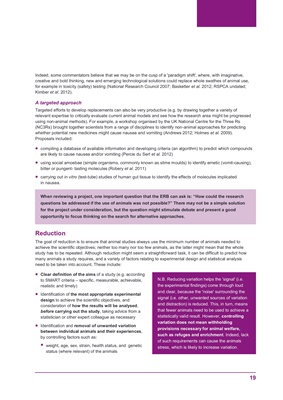
19
Indeed, some commentators believe that we may be on the cusp of a 'paradigm shift', where, with imaginative,
creative and bold thinking, new and emerging technological solutions could replace whole swathes of animal use,
for example in toxicity (safety) testing (National Research Council 2007; Basketter et al. 2012; RSPCA undated;
Kimber et al. 2012).
A targeted approach
Targeted efforts to develop replacements can also be very productive (e.g. by drawing together a variety of
relevant expertise to critically evaluate current animal models and see how the research area might be progressed
using non-animal methods). For example, a workshop organised by the UK National Centre for the Three Rs
(NC3Rs) brought together scientists from a range of disciplines to identify non-animal approaches for predicting
whether potential new medicines might cause nausea and vomiting (Andrews 2012; Holmes et al. 2009).
Proposals included:
compiling a database of available information and developing criteria (an algorithm) to predict which compounds
are likely to cause nausea and/or vomiting (Percie du Sert et al. 2012)
using social amoebae (simple organisms, commonly known as slime moulds) to identify emetic (vomit-causing),
bitter or pungent- tasting molecules (Robery et al. 2011)
carrying out in vitro (test-tube) studies of human gut tissue to identify the effects of molecules implicated
in nausea.
Reduction
The goal of reduction is to ensure that animal studies always use the minimum number of animals needed to
achieve the scientific objectives; neither too many nor too few animals, as the latter might mean that the whole
study has to be repeated. Although reduction might seem a straightforward task, it can be difficult to predict how
many animals a study requires, and a variety of factors relating to experimental design and statistical analysis
need to be taken into account. These include:
Clear definition of the aims of a study (e.g. according
to SMART criteria - specific, measurable, achievable,
realistic and timely)
Identification of the most appropriate experimental
design to achieve the scientific objectives, and
consideration of how the results will be analysed,
before carrying out the study, taking advice from a
statistician or other expert colleague as necessary
Identification and removal of unwanted variation
between individual animals and their experiences,
by controlling factors such as:
weight, age, sex, strain, health status, and genetic
status (where relevant) of the animals
When reviewing a project, one important question that the ERB can ask is: "How could the research
questions be addressed if the use of animals was not possible?" There may not be a simple solution
for the project under consideration, but the question might stimulate debate and present a good
opportunity to focus thinking on the search for alternative approaches.
N.B. Reducing variation helps the 'signal' (i.e.
the experimental findings) come through loud
and clear, because the 'noise' surrounding the
signal (i.e. other, unwanted sources of variation
and distraction) is reduced. This, in turn, means
that fewer animals need to be used to achieve a
statistically valid result. However, controlling
variation does not mean withholding
provisions necessary for animal welfare,
such as refuges and enrichment. Indeed, lack
of such requirements can cause the animals
stress, which is likely to increase variation.